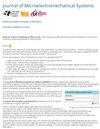硅侧壁高深度FIB蚀刻:耦合入射角和初始多槽表面形貌
IF 3.1
3区 工程技术
Q2 ENGINEERING, ELECTRICAL & ELECTRONIC
引用次数: 0
摘要
聚焦离子束(FIB)蚀刻在硅侧壁表面对提高微机电系统(MEMS)器件的性能具有重要意义。然而,在功能表面上进行高深度刻蚀需要离子束向具有初始形貌的表面倾斜,这对揭示离子束-硅固体相互作用机制提出了显着的挑战。本文通过引入入射角和初始多凹槽表面的耦合,建立了硅侧壁上FIB蚀刻离子-固体相互作用的分子动力学模型。通过对电感耦合等离子体(ICP)制备的多沟槽硅侧壁表面进行FIB倾斜刻蚀,验证了该模型的正确性。在125~\mu $ m深度的硅侧壁上,将离子束倾斜一定的入射角,可将目标表面粗糙度Ra从126 nm降低到4 nm。我们还发现了初始多沟槽形貌对加工侧壁表面的遗传效应。结果表明,减小离子束的入射角可以减小遗传效应。此外,将FIB倾斜蚀刻应用于ICP蚀刻MEMS光开关的侧壁微镜表面。采用20°入射角,加工面积为177~\mu $ m × 125~\mu $ m的侧壁表面。MEMS开关的光传输效率由6.9%提高到34.6%。本研究对于扩大FIB蚀刻在MEMS器件上的应用范围具有重要意义。(2024 - 0212)本文章由计算机程序翻译,如有差异,请以英文原文为准。
High-Depth FIB Etching on Silicon Sidewall: Coupling Incidence Angle and Initial Multi-Groove Surface Topography
Focused-ion-beam (FIB) etching on the silicon sidewall surface is significant for improving the performance of micro-electro-mechanical system (MEMS) device. However, the high-depth etching on the functional surface requires the ion beam to be inclined to the surface with an initial topography, posing a notable challenge in revealing the ion beam-silicon solid interaction mechanism. In this article, we propose a molecular dynamic model for the ion-solid interaction of FIB etching on the silicon sidewall by introducing the coupling of incidence angle and initial multi-groove surface. The model is validated by conducting FIB tilted etching on a multi-groove silicon sidewall surface fabricated by inductively coupled plasma (ICP). By tilting the ion beam with an incidence angle, the target surface roughness Ra can be reduced from 126 nm to 4 nm on a $125~\mu $ m-depth silicon sidewall. We also found the inheritable effect of initial multi-groove topography on the processed sidewall surface. Results show that the inheritable effect can be reduced by decreasing the incidence angle of the ion beam. Furthermore, FIB tilted etching is applied to the sidewall micro-mirror surface of an ICP etched MEMS optical switch. By using an incidence angle of 20°, the sidewall surface with an area of $177~\mu $ m $\times 125~\mu $ m is processed. The optical transmission efficiency of the MEMS switch increases from 6.9% to 34.6%. We believe this work is significant for expanding the application range of FIB etching on MEMS devices. [2024-0212]
求助全文
通过发布文献求助,成功后即可免费获取论文全文。
去求助
来源期刊

Journal of Microelectromechanical Systems
工程技术-工程:电子与电气
CiteScore
6.20
自引率
7.40%
发文量
115
审稿时长
7.5 months
期刊介绍:
The topics of interest include, but are not limited to: devices ranging in size from microns to millimeters, IC-compatible fabrication techniques, other fabrication techniques, measurement of micro phenomena, theoretical results, new materials and designs, micro actuators, micro robots, micro batteries, bearings, wear, reliability, electrical interconnections, micro telemanipulation, and standards appropriate to MEMS. Application examples and application oriented devices in fluidics, optics, bio-medical engineering, etc., are also of central interest.
 求助内容:
求助内容: 应助结果提醒方式:
应助结果提醒方式:


